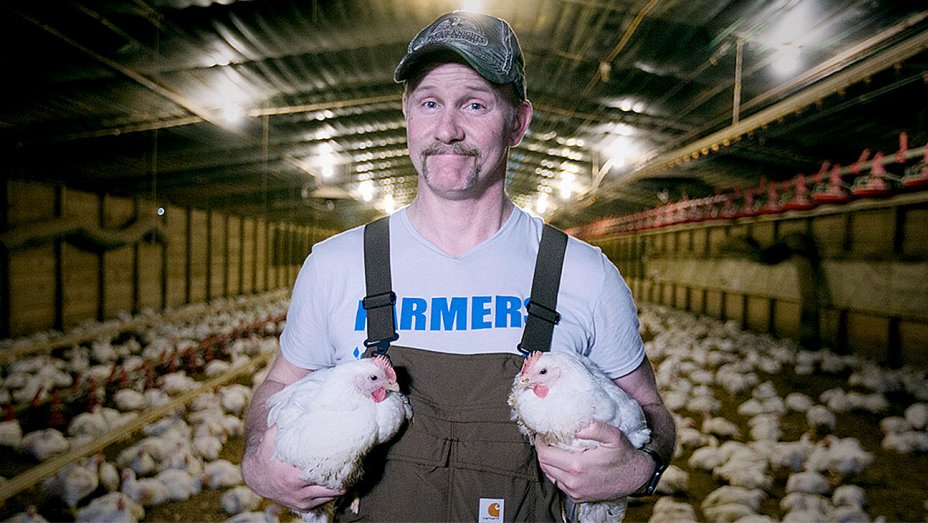The Hollywood Reporter: ‘Super Size Me 2: Holy Chicken!’: Film Review
8:46 AM PDT 9/9/2017 by Leslie Felperin
Morgan Spurlock ruffles the feathers of the powerful chicken industry in this follow-up to his 2004 documentary hit ‘Super Size Me.’
Thirteen years on from his exposé Super Size Me — the film that significantly shifted public perceptions of junk food, and especially the McDonald’s chain — documentarian Morgan Spurlock returns for a second helping with Super Size Me 2: Holy Chicken! Smartly readjusting the ratios to focus less on the health effects of fast food and more on the oligopoly-run farming industry and the food trade’s sneaky marketing tactics, Spurlock goes “cluck-raking,” as it were, to expose the dark-meat side of chicken consumption by starting his own restaurant. (Promise: No more poultry puns after this.) Jaunty but thought-provoking, the doc ought to do well, although the film marketplace itself has probably changed too much in the last decade to repeat Super Size Me’s box-office success.
Spurlock’s smart move here is to shift the focus away from explaining just how bad high-calorie highly-processed food is because, duh, we know all that now. Instead, Holy Chicken! exposes how the agri-food business uses deceptive but legal buzz words and semiotic persiflage to create a “health halo” around certain foods and brands in order to con consumers into thinking their products are greener, more humanely produced and generally better for you (spoiler: they’re not really) than the Big Macs and Whoppers of old. Clearly, consumers want to, or at least think they want to, eat more healthily and the industry wants to service that desire. That’s why there’s kale on the menu at some fast-food joints, and other low-fat options available, a shift partly attributable to the first Super Size Me itself.
Choosing to beat ‘em by joining ‘em first, and aware of the fact that chicken now outstrips beef in sales (fun fact: Every second, 43 pounds of chicken are consumed worldwide), Spurlock decides to learn about what’s going on in this industry by starting his own restaurant. Knowing only that he’s going to serve chicken, he first approaches agency CCD Innovation to develop his menu according to current culinary trends and consumer research, and eventually they create for him a crispy (“fried” is the new “f word”) panko-crumbed chicken filet with charcoal stenciled on the surface to make it look grilled.
But the real meat of the movie are the sections about chicken farming, which see Spurlock hiring third-generation Alabama chicken farmer Jonathan Buttram to help him raise a flock of big-breasted broilers from hatchlings to fryer-ready fodder. In the process, Spurlock and the audience learn just how vague the FDA’s definition of “free-range” is. As long as he sets up a closet-sized area attached to the barn space that the chickens can access for a proscribed amount of time every day, then that’s good enough to call it free range. Likewise, the film lays bare the hollowness of virtue-signaling, “greenwashing” terms like “natural,” “hormone-free” and the like, which don’t cancel out the fact that 98 percent of the poultry we eat comes from one specific breed that grows so fast it can barely walk, is raised in big windowless warehouse spaces and is nourished with feed that contains pork products and lots of chemicals — but, yes, no hormones.
Moreover, what Spurlock dubs “Big Chicken” as an umbrella term for the industry consists of just five mega corporations (Tyson, Pilgrim’s Pride, Sanderson Farms, Perdue Foods and Koch Foods) who have a stranglehold over farmers like Buttram. These companies punish farmers who complain about such ruthless practices as the tournament system, which pays out less to farmers found wanting for often vague reasons or anyone who refuses to pay up for “improvements” to their facilities that keep them in permanent debt to the conglomerates.
Spurlock and his team put all this information and more right up on the walls (in a cozy, quasi-handwritten font, of course) of his chicken restaurant when it opens, creating a bizarre product that both critiques and eats itself, with slogans plastered everywhere that lampoon the absurdity of health halo-ing and greenwashing endemic throughout the industry (“No added asbestos or plutonium!”). The result is ingenious; end titles reveal some companies have come forward wanting to franchise the concept.
As a brand in his own right, Spurlock has a crucial strength: He’s a good interviewer, photogenic without seeming old-school-TV-reporter slick, witty but not caustic and, unlike, say, Michael Moore, capable of constructing a clearly defined case without appearing to hector the viewer with political rhetoric. The filmmaking, with its perky musical score and energetic camerawork, reflects that accessible ethos.
Still, one of the weak spots of the film’s case is that it doesn’t offer any real solutions, or acknowledge that there’s a class component in the equation. When, at one point, Spurlock and a couple of hipster marketing bros go on a restaurant crawl to taste the competition, sneering and wise-cracking all the way, some might feel their disdain reflects a very post-Trumpian divide in American culture today, between metropolitan elites who can afford to buy organic and those who can’t and have to live in places like Ohio, and have fewer economic choices about where they add protein in their diets. It’s not hard to predict from which constituency the film will draw more viewers.
Production companies: Warrior Poets, Snoot Entertainment, Public Domain
With: Morgan Spurlock, Jonathan Buttram
Director: Morgan Spurlock
Screenwriters: Morgan Spurlock, Jeremy Chilnick
Producers: Keith Calder, Morgan Spurlock, Jeremy Chilnick, Matthew Galkin, Spencer Silna, Jessica Calder, Nicole Barton
Director of photography: David Garcia-Vlasits
Production designer: Rachel Rockstroh
Editor: Pierre Takal
Music: David Tobin, Tim Garland, Jeff Meegan
Venue: Toronto International Film Festival
Sales: Cinetic Media
